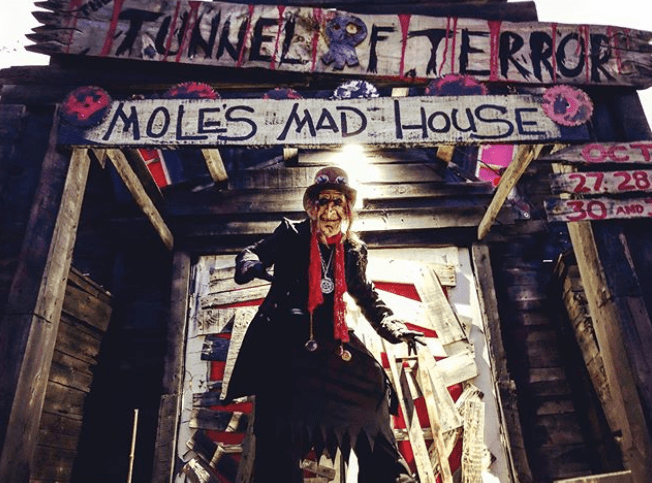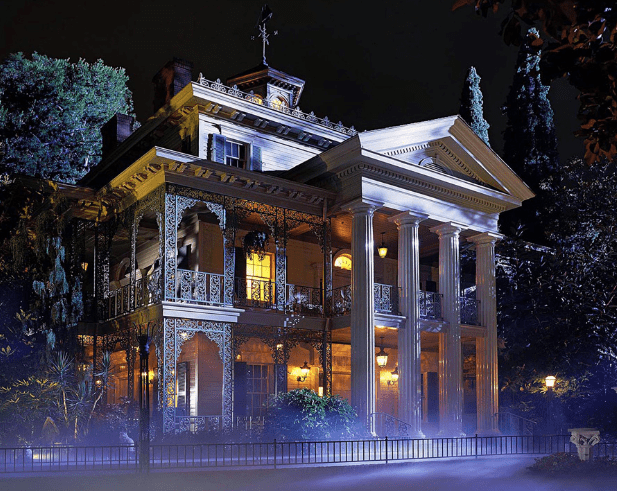Attractions built to cause fear have been a feature of human history for at least the past three centuries. As humanity’s control over nature has increased, we have developed the capability to construct our own fictional places to immerse ourselves in constructed realities. One sort of constructed reality is the interior of a haunted house. There we can face our fears in a controlled environment.
Prepared events with the aim of terrifying are equally old, and one of the first, the French Fantasmagorie even featured light and stage tricks to further the illusion of the supernatural. A wax modeller, Philippe Curtius, developed accurate wax representations of well known French murderers. He took on an apprentice, the infamous Madame Tussaud, who took the concept and adapted it for a British audience in 1802. If you were to visit her early “seperate chambers” at her house of wax figures you would be confronted by gruesome recreations of the severed heads of famous French Revolutionaries alongside the detailed replicas of famous murderers. While not a haunted house in the strictest sense, this sort of attraction served as a proof of concept for the Spook Industry. Madame Tussaud’s wax terrors continued to frighten and amaze for the next two hundred years, before finally shuttering in 2016, replaced with a Sherlock Holmes theme.
With the rise of industrial society, enterprising spookmongers sought to marry horror and technology to accomplish more advanced feats of fright, which led to the steam powered Orton and Spooner Ghost House whose tricks and scares were supported by steam engine. The Spooner House also shows the commodification of fright, as the attraction was constructed by a fair ride manufacturer, beating Disney’s Haunted Mansion to market by half a century. Such attractions were local novelties, built for a single purpose or attached to a larger attraction, such as a fair or the rest of Madame Tussaud’s wax exhibition. They had yet to become the stars of the show.
The expansion of Halloween as a consumer holiday started in the era of the Great Depression. The growth of Halloween also brought another critical element to the forefront of the Spook Industry – a “Do it Yourself” or DIY mentality. American families realized they could make their own fun with some cardboard cut in the shape of a cat, very dark rooms, and stringy fake spider webs. Suddenly haunted events were happening in people’s basements, attics, and family rooms on tight budgets and with a community element. On their trick-or-treat route, children may have visited several of these haunted houses.
DIY haunted experiences are a continuing tradition, and have melded well into the Spook Industry. Today, such attractions like Niagara’s Tunnel of Terror draw hundreds of visitors daily and even more importantly, use their proceeds to contribute to charity. David and Karyn Torbett, the creators and operators of the Tunnel of Terror spoke with our Haunted Talks Podcast about the DIY element and Community aspect in Episode 46:
Speaking of Spooks for charity, the Haunted Walk has hosted “Incident at the Bunker: A Zombie Adventure,” for the past eight years. This event is a major fundraiser for the Diefenbunker: Canadian Cold War Museum, and a proud part of our lineup.
Of course, it would be shameful not to mention the most influential Haunted House of them all, Disney’s Haunted Mansion. Opened in 1969, we dedicated an entire episode to this mechanical marvel, Episode 50 of the Haunted Talks Podcast:
The simple fact is that with the Haunted Mansion, an excellent balance of horror and fun was discovered. As you experience the stretching room you would feel a sense of unease, but at the same time much of the presentation is also humorous and fun.
The greatest gift of Disney’s Haunted Mansion has been its immense cultural impact. More than just a simple attraction, this haunted house is also a cultural export, with Disney as the ambassador. The experience provides a taste of North American spookiness to millions around the world thanks to its sister attraction in Tokyo. For comparison, Japan’s more traditional attractions focus more on ghosts and are more quiet than their North American counterparts.
This set of Disney attractions cemented not just the image of the haunted house in popular culture, but also defined their purpose. They had to be frightening, but also fun and exciting. This is a natural balance that Haunting Industry has been grappling with since its very start.
This year we introduced two new immersive haunted house attractions ourselves that channel good scares with spooky fun: The Hauntings at Black Creek (Toronto) and Laurier House (Ottawa).
On the other side of the spectrum is the McKamey Manor, which features a forty page waiver and genuine torture. Simulated drowning, sensory deprivation, and physical pain are all provided to the entrant. Such an attraction’s presence in the same grouping as the traditional haunted house remains a point of debate. Other experiences, such as Pennsylvania’s East State Penitentiary lean into the horror and terror side of the experience, but do not go as far as McKamey Manor. This high production value attraction features many paid actors, who support the operation of the event and engage with people ready to be spooked. With these extreme attractions the spectrum of the haunted house is complete, from the local DIY event, to the perfect mix of the Disney Haunted Mansion, ending with the most scary private events like those operated at the East State Penitentiary.
From eerily accurate wax severed heads to a purpose built haunted house which measures its flow in thousands of visitors per hour, the Haunted House has been a popular and enduring symbol of Spooktober and Halloween. So when you pass by that old dilapidated house, alone on top of a hill, where the whispering of leaves could be mistaken for voices, just think of the long history of the Haunted House, and know that there is always another scary story waiting to be told.
Written by Ezra Beudot


